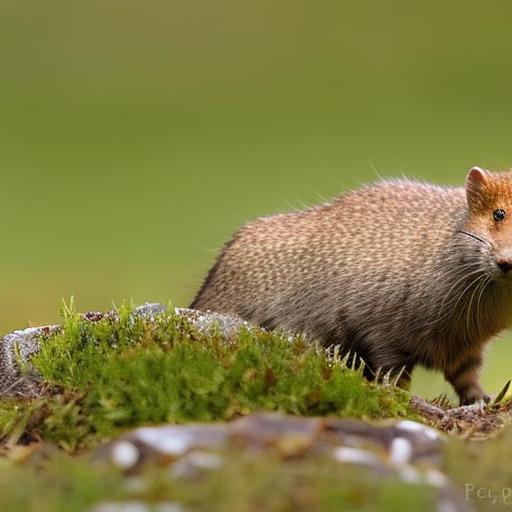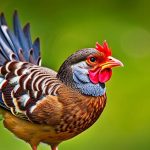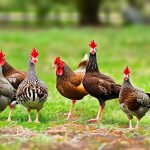Minks are small, carnivorous mammals that can pose a significant threat to chickens. As chicken owners, it is crucial to understand the dangers that minks present and take necessary measures to protect our feathered friends. Chickens are vulnerable to a variety of predators, and minks are no exception. By fortifying our chicken coops, implementing deterrents, and educating ourselves on mink behavior, we can create a safe and secure environment for our chickens.
Key Takeaways
- Minks are a serious threat to chickens and can cause significant damage.
- Signs of mink activity include missing chickens, feathers, and droppings.
- Fortify your chicken coop with secure locks, wire mesh, and predator-proof flooring.
- Choose fencing that is at least 3 feet high and buried at least 6 inches underground.
- Implement deterrents such as motion-activated lights, noise makers, and predator urine.
Understanding the Threat of Minks to Your Chickens
Minks are natural predators with a strong instinct for hunting. They are known for their agility, speed, and ability to swim, making them formidable opponents for chickens. Minks have sharp teeth and claws that allow them to easily kill and consume small animals like chickens. They are opportunistic hunters and will take advantage of any opportunity to prey on vulnerable animals.
Minks are primarily nocturnal creatures, which means they are most active during the night. This makes it difficult for chicken owners to monitor their activities and protect their flocks. Minks are also excellent climbers and can easily scale fences or walls to gain access to chicken coops. Their small size allows them to squeeze through small openings or gaps in the coop, making it even more challenging to keep them out.
Identifying Signs of Mink Activity on Your Property
To effectively protect your chickens from minks, it is essential to be able to identify signs of mink activity on your property. One of the most obvious signs is the presence of mink tracks. Mink tracks resemble those of other members of the weasel family, with five toes on both the front and hind feet. These tracks can often be found near water sources or areas where chickens frequent.
Another sign of mink activity is their droppings, also known as scat. Mink scat is typically dark brown or black in color and has a twisted, tubular shape. It may contain the remains of feathers, bones, or fur from their prey. Finding mink scat near your chicken coop or in areas where chickens roam is a clear indication of their presence.
Fortifying Your Chicken Coop Against Mink Attacks
| Fortification Method | Effectiveness | Cost |
|---|---|---|
| Hardware Cloth | High | |
| Electric Fencing | Very High | |
| Concrete Foundation | High | |
| Steel Mesh | High | |
| Aluminum Flashing | Low |
Securing your chicken coop is crucial to protect your chickens from mink attacks. Minks are skilled at finding weak points in fences or coop structures, so it is essential to reinforce these areas. Start by inspecting the coop for any gaps, holes, or loose boards that minks could exploit. Repair or replace any damaged sections to ensure there are no entry points for minks.
Consider using hardware cloth instead of regular chicken wire for the walls and roof of your coop. Hardware cloth has smaller openings and is more durable, making it harder for minks to break through. Make sure to bury the hardware cloth at least 12 inches into the ground around the perimeter of the coop to prevent minks from digging underneath.
Choosing the Right Type of Fencing to Keep Minks Out
Choosing the right type of fencing is crucial when it comes to keeping minks out of your chicken coop. Minks are excellent climbers and can easily scale traditional chicken wire fences. To deter them, consider using a woven wire fence with smaller openings or a solid barrier such as a wooden fence.
Electric fencing can also be an effective deterrent against minks. Install an electric wire about 6 inches above the ground and another one about 6 inches above that. This will create a barrier that minks will be reluctant to cross. Make sure to regularly check the electric fence for any damage or malfunctions.
Implementing Mink Deterrents Around Your Chicken Coop

In addition to fortifying your chicken coop, implementing mink deterrents around your property can help keep these predators at bay. One effective deterrent is the use of motion-activated lights or sprinklers. Minks are nocturnal creatures and are startled by sudden bursts of light or water. Placing these deterrents near the chicken coop can help deter minks from approaching.
Another option is to use predator scent repellents. Minks are territorial animals, and the scent of a larger predator can discourage them from entering an area. Fox urine or coyote urine can be purchased from hunting supply stores and applied around the perimeter of your chicken coop.
Using Traps and Other Control Methods to Remove Minks from Your Property
If you have identified mink activity on your property, it may be necessary to remove them to protect your chickens. Trapping is one effective method for capturing and removing minks. Live traps can be baited with fish or other meat-based baits and placed near areas where mink activity has been observed. Check the traps regularly and release any captured minks far away from your property.
It is important to note that trapping and relocating wildlife may require a permit in some areas. Check with your local wildlife officials to ensure you are following the proper procedures and regulations.
Keeping Your Chickens Safe from Minks During Free-Range Time
Allowing chickens to free-range can provide them with exercise, fresh air, and access to natural food sources. However, it also exposes them to potential predators like minks. To keep your chickens safe during free-range time, consider using portable electric fencing to create a secure area for them to roam.
You can also supervise their free-range time and keep a close eye on their surroundings. If you notice any signs of mink activity or see a mink approaching, quickly gather your chickens and return them to the safety of their coop.
Creating a Safe and Secure Habitat for Your Chickens
Creating a safe and secure habitat for your chickens is essential for their overall well-being and protection from predators like minks. Start by providing adequate shelter in the form of a sturdy coop with secure doors and windows. Make sure the coop is well-ventilated and provides enough space for your chickens to move around comfortably.
In addition to a secure coop, provide a fenced outdoor area for your chickens to roam during the day. This area should be protected with the same fortifications and deterrents mentioned earlier to keep minks out. Regularly inspect the fencing and repair any damage to ensure its effectiveness.
Educating Yourself on Mink Behavior and Habits
Educating yourself on mink behavior and habits is crucial for effectively protecting your chickens. Understanding how minks hunt, their preferred habitats, and their patterns of activity can help you anticipate their behavior and take appropriate preventive measures.
There are numerous resources available online, including articles, books, and videos, that provide valuable information on mink behavior. Local wildlife officials or experienced chicken owners in your area may also be able to provide insights and advice based on their own experiences.
Working with Local Wildlife Officials to Manage Mink Populations in Your Area
Managing mink populations in your area is not only beneficial for protecting your chickens but also for maintaining a healthy ecosystem. Minks play an important role in the natural balance of wildlife populations, but an overabundance can lead to conflicts with humans and domestic animals.
Reach out to your local wildlife officials to learn about any management programs or initiatives in place for controlling mink populations. They can provide guidance on trapping, relocation, or other methods that may be necessary to address the issue.
Keeping chickens safe from minks requires a combination of fortifying your chicken coop, implementing deterrents, and educating yourself on mink behavior. By taking proactive measures to protect your chickens, you can create a safe and secure environment for them to thrive. Remember to regularly inspect your coop and fencing, monitor for signs of mink activity, and work with local wildlife officials to manage mink populations in your area. With these precautions in place, you can enjoy the company of your chickens without the constant worry of mink attacks.
If you’re looking for ways to protect your chickens from minks, you’ll definitely want to check out this article on Poultry Wizard: https://poultrywizard.com/keeping-chickens/chicken-coop-interior-ideas/. It provides valuable insights and tips on how to design the interior of your chicken coop in a way that deters minks and keeps your feathered friends safe. Don’t miss out on this helpful resource!
FAQs
What are minks?
Minks are small, semi-aquatic mammals that belong to the weasel family. They are known for their sleek fur and sharp teeth.
Why do minks attack chickens?
Minks are natural predators and are known to attack and kill small animals, including chickens. They are attracted to the smell and movement of the birds.
What are the signs of a mink attack on chickens?
Signs of a mink attack on chickens include missing birds, scattered feathers, and bite marks on the remaining birds.
How can I keep minks away from my chickens?
To keep minks away from your chickens, you can install a sturdy fence around the coop and run, use motion-activated lights and sound devices, and keep the area clean and free of food scraps.
What should I do if I suspect a mink attack on my chickens?
If you suspect a mink attack on your chickens, you should inspect the area for signs of the predator and remove any dead or injured birds. You should also reinforce your coop and run to prevent future attacks.
Meet Walter, the feathered-friend fanatic of Florida! Nestled in the sunshine state, Walter struts through life with his feathered companions, clucking his way to happiness. With a coop that’s fancier than a five-star hotel, he’s the Don Juan of the chicken world. When he’s not teaching his hens to do the cha-cha, you’ll find him in a heated debate with his prized rooster, Sir Clucks-a-Lot. Walter’s poultry passion is no yolk; he’s the sunny-side-up guy you never knew you needed in your flock of friends!







